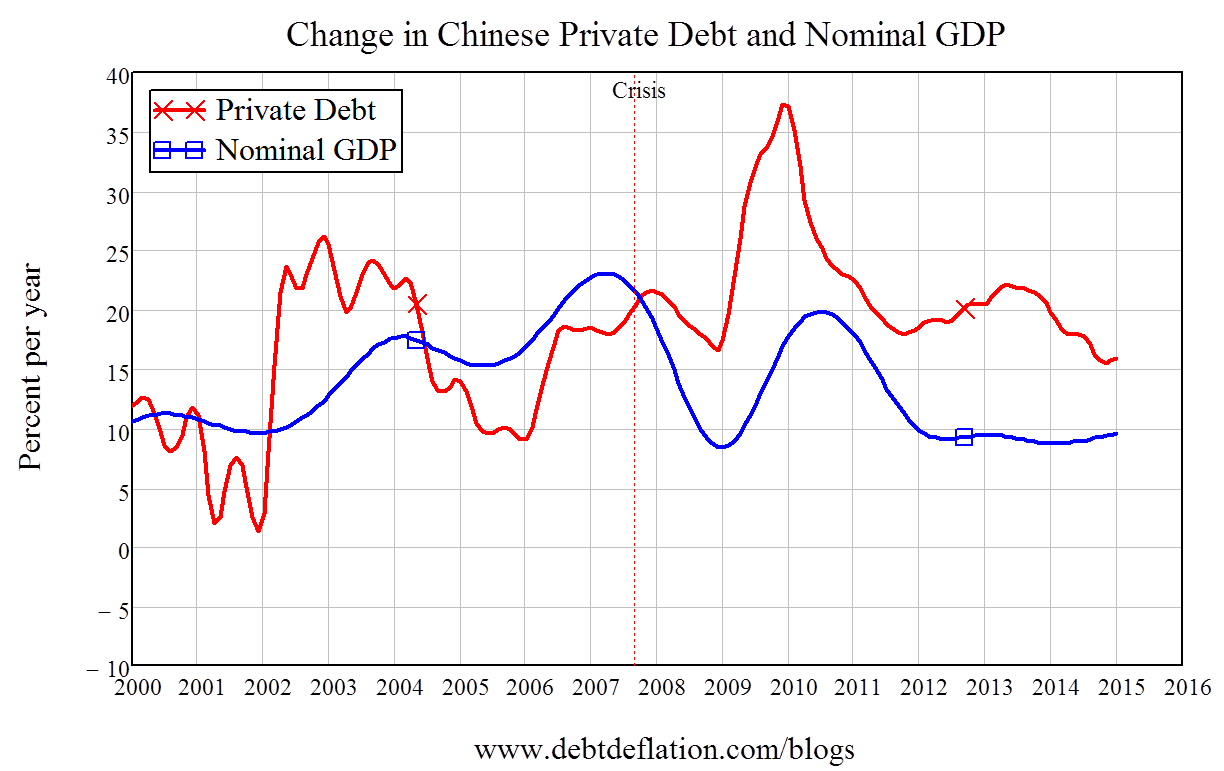As I noted last week, the previous crash of China’s stock market in 2007 lacked the two essential pre-requisites for a genuine crisis: private debt was only about 100% of GDP and it had been relatively constant for the previous decade. This bust however is the real deal, because unlike the 2007-08 crash, the essential ingredients of excessive private debt and excessive growth in that debt are well and truly in place.
China’s resilience against credit crises came to an end in 2009, when in a response to government directives, Chinese banks began lending to anyone with a pulse. As Figure 3 in last week’s post showed (reproduced below as Figure 3 below), the growth in private debt rocketed from 17% per year at the beginning of 2009 (versus nominal GDP growth of 8% at the same time) to 37% per year by the beginning of 2010 (nominal GDP growth peaked six months later at 20% per year). By the beginning of this year, private debt had hit 180% of GDP and had grown by over 80% of GDP in the previous seven years.
This was the fastest growth in credit in any country, EVER. It dwarfs both Japan’s Bubble Economy and the USA’s combination of the DotCom and Subprime Bubbles. China’s bubble drove private debt up by as much in 5 years as Japan managed in over 17 years, and more than the USA’s debt rose in the entire Clinton-Bush debt bubble from 1993 until 2010 (see Figure 1).
Figure 1: China’s credit bubble grew as much in 5 years as Japan’s did in 18

Since last week’s post, the crash in the Shanghai stock market has gone into overdrive. Shares fell 8.5% today, bringing the fall in the index to 20% in the last 5 days (see Figure 2) and 37% since the market peaked on June 12.

This is the downside of the credit bubble that China used to sidestep the Global Financial Crisis in 2008. It kept the wheels of the Chinese economy spinning when they had threatened to seize up in 2008, but it set China up for the fall it is now experiencing—and this fall is not going to be limited to the Shanghai Index.
Much of the 80%+ of GDP borrowed since 2009 went into property speculation by developers, which in turn fueled much of the apparent growth of the Chinese economy. One key peculiarity about China’s economy—and there are many—is that much of its growth has come from the expansion of industries established by local governments (“State Owned Enterprises” or SOEs). Those factories have been funded partly by local governments selling property to developers (who then on-sold it to property speculators for a profit while house prices were rising) and partly by SOE borrowing. The income from those factories in turn underwrote the capacity of those speculators to finance their “investments” and it contributed to China’s recent illusory 7% real growth rate.
With property price appreciation now over, those over-levered property developers aren’t buying local government land any more and one of the two sources of finance for SOEs is now gone. Borrowing is still there of course, and the Central Government will probably require local councils to continue borrowing to try to keep the growth figures up. But the SOEs are already losing money, and this will just add to the Ponzi scheme. The collapse of China’s asset bubbles will therefore hit Chinese GDP growth much more directly than the crashes in the more fully capitalist nations of Japan and the USA.
Figure 3: Change in private debt and change in nominal GDP

The growth in asset prices had to end because asset price growth is driven not by the growth in debt, but by its acceleration. That’s the rub in China’s over-the-top and futile attempts to stop the stock market from falling: they can keep private debt rising for a while, but they can’t keep it accelerating forever. Though private debt is still rising—and probably will keep rising for another year or more—its acceleration is already negative and likely to stay there for at least as long.
Figure 4: Private debt growth in China is now decelerating, taking down GDP growth and asset prices with it

So this China crash is real, and it won’t be restricted to the stock market. For the past 30 years, China has enjoyed the upside of the capitalist road. Now it has to navigate its downside.
